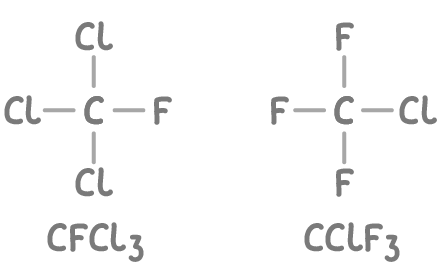Halogenoalkanes and the Environment
This lesson covers:
- What chlorofluorocarbons (CFCs) are
- How CFCs reach the ozone layer
- The role of chlorine radicals in ozone depletion
- CFC alternatives
Chlorofluorocarbons are stable halogenoalkanes
Chlorofluorocarbons (CFCs) are a type of halogenoalkane containing only carbon, chlorine and fluorine.
Key features include:
- They contain no C-H bonds as all hydrogen atoms are substituted by chlorine and fluorine.
- Common examples are CCl3F (trichlorofluoromethane) and CClF3 (chlorotrifluoromethane).

CFCs were widely used industrially and domestically as refrigerants, propellants and solvents until the late 1980s.
Their widespread use was due to properties like:
- High stability
- Low toxicity
- Non-flammability
- Volatility
Their high stability is a result of the strong carbon-halogen bonds.
How CFCs reach the ozone layer
Ozone (O3) in the upper atmosphere acts as a protective barrier by absorbing harmful ultraviolet (UV) radiation from the sun. This "ozone layer" prevents damage to humans and ecosystems.
While very stable at ground level, CFC molecules can survive long enough in the atmosphere to be carried up into the stratosphere. High-energy UV radiation breaks the carbon-halogen bond, releasing chlorine radicals. For example,
CF2Cl2 ➔ CF2Cl• + Cl•
Chlorine radicals destroy ozone
Chlorine radicals initiate a chain reaction that rapidly depletes ozone through a series of propagation reactions:
- UV radiation forms chlorine radicals (Cl•) which react with ozone molecules:
Cl• + O3 ➔ ClO• + O2
- The chlorine radical is regenerated:
ClO• + O3 ➔ Cl• + 2O2
The overall effect of these reactions is:
2O3 ➔ 3O2
This cycle allows a single chlorine radical to destroy more than 10,000 ozone molecules. The resulting depletion forms "holes" in the ozone layer, increasing UV radiation penetration.
Alternatives to CFCs
In response to the environmental damage caused by CFCs, the 1989 Montreal Protocol imposed a global ban on CFC production by 2000. Currently, their use is limited to specific applications like medical inhalers and submarine systems.
Scientists and environmentalists support the reduction of CFCs and are working on developing safer alternatives:
- Hydrofluorocarbons (HFCs) - These do not contain chlorine, so they do not harm the ozone layer, but they are powerful greenhouse gases.
- Hydrocarbons - These substances decompose rapidly but are flammable and contribute to greenhouse gas emissions.
Though these alternatives are not perfect, they are less harmful to the environment than CFCs. Continuous efforts are being made to improve these substances while monitoring the gradual recovery of the ozone layer.